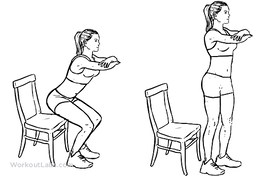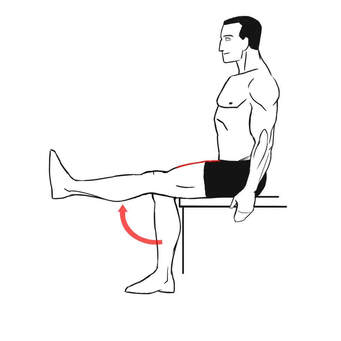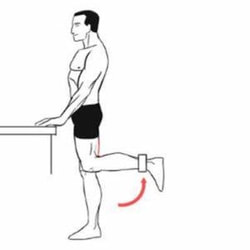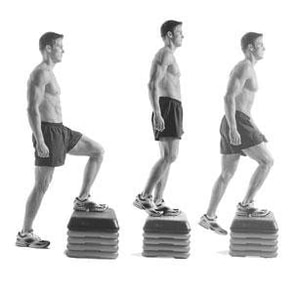 Osteoarthritis is the leading cause of hip and knee replacements in Australia, with every 1 in 11 people having some form of Osteoarthritis. Strengthening the muscles around the knee joint can decrease the load put through the joint and as a result decrease pain levels and stiffness. But… What are the best exercises to be doing to achieve this? 1. Squat (to chair) Completing a squat or modified squat to a chair is a fantastic way to build strength in the quadriceps, hamstrings and gluteal’s which all sit above the knee joint. Start by sitting on a chair with your feet on the ground, hip width apart and crossing your arms over your chest. Begin squeezing through the bottom and push yourself upright to be standing, once at full extension, begin slowly lowering back down to the chair. Try starting with 2 sets of 10 repetitions and building up from there.  2. Seated knee extension A knee extension focuses predominantly on strengthening the quadricep muscle at the front of the thigh. Begin by sitting in a chair with your feet just slightly off the ground. Start with the right leg and straighten your leg out fully, before slowly lowering the leg back down to a bent knee position. Swap to the left leg and complete the same movement. To increase the difficulty of the exercise try adding ankle weights or a resistance band attached to the back leg of the chair to further build strength in the quadricep. Begin with 2 sets of 12 repetitions on each leg and gradually increase.  3. Standing knee flexion Knee flexion is the opposite movement of knee extension which involves bending at the knee to strengthen the hamstring muscle at the back of the thigh. Start in a standing position near a wall or bar for support, then shift your weight to your right leg, begin to bend your left knee, bringing your heel up towards your bottom, before slowly lowering back down to the ground. Swap to the right leg and repeat. To increase the difficulty of the movement, add some ankle weights or attach a resistance band to something stable in front of the feet to further progress strength in the hamstring. Begin with 2 sets of 12 repetitions on each leg and increase slowly.  4. Step ups Step ups provide many benefits to not only knee osteoarthritis but also improving overall function and stability of the pelvis and legs. Step ups assist in developing not only lower limb strength but also balance too. Start with a low step and firstly place your right foot up onto the step followed by your left foot. Then return your right foot back down to the ground first, followed by your left foot. Ensure that your knees are tracking over your feet/ toes when stepping up and down off the step. Begin with 2 sets or 8 repetitions on each leg and increase both the height of the step and the number or sets and repetitions to continually improve. If you experience knee osteoarthritis or would like to improve your overall lower body strength and joint function, give these 4 exercises a go at home. If you have any further questions about knee Osteoarthritis or how exercise can assist in decreasing pain levels, please email us at [email protected]. By, Aleisha Michael. Accredited Exercise Physiologist
1 Comment
ROBINSON
6/8/2021 05:20:59 pm
I don't usually talk much on the internet but I had to open up this time because a miracle happened in my life and my uncle's life. After struggling with Amyotrophic Lateral Sclerosis ALS/MND, and My uncle with Parkinson's Disease too, for five years, We finally got helped by Dr. Ziza's, World Herbs Clinic Head doctor. keeping it to myself will be selfish of me. We used his herbal remedy for Three months and was fully reversed and now we have no symptoms of both condition. I urge you all having ALS/MND, and Parkinson's to give him a try.
Reply
Your comment will be posted after it is approved.
Leave a Reply. |
AuthorSLisa Parkinson Archives
July 2024
Categories
All
|

 RSS Feed
RSS Feed